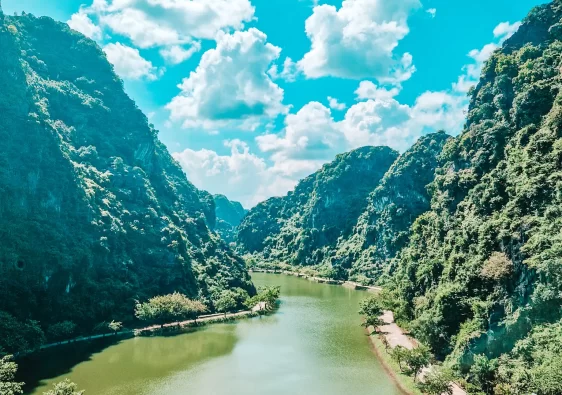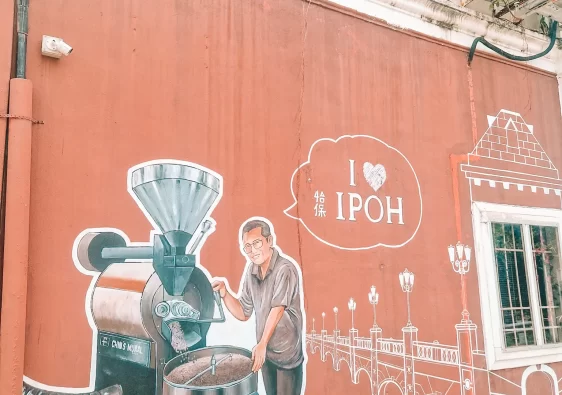Wondering what day trips you can take from Hoi An or Da Nang that go beyond the usual lantern-lit strolls or beachside lounging? I get it—Hoi An is magical, but after a few days of tailoring appointments and ambling through the Old Town, you might be craving something more. A change of scenery. A deeper dive into Vietnam’s rich culture, or simply a moment of quiet away from the crowds. Let me show you the best ways to enrich your Central Vietnam itinerary with easy, unforgettable escapes that spark reflection, connection, and a little thrill.
Just so you know, this post contains affiliate links. If you book a tour, hotel, or buy something through one of these links, I may earn a small commission—at no extra cost to you. It helps me keep this blog running and full of travel tips. Thanks for the support!

Why take a day trip from Da Nang or Hoi An?
Both Hoi An and Da Nang have a range of things to do without leaving the city. You can spend time exploring the beauty of Hoi An, a UNESCO Heritage city, or jumping between delicious cafes in Da Nang.
But after spending three months living in this corner of Vietnam—and visiting Hoi An three times since 2010 —I know firsthand how rewarding it is to explore beyond the city limits. There are countless rewarding day trips from Da Nang and Hoi An that will take you beyond the usual tourist trail. Whether you’re riding pillion with an Easy Rider through the cloud-kissed Hai Van Pass (an experience I’ll never forget) or sipping local salt coffee in a book-filled café hidden among the rice fields, there’s a world of contrast and beauty just a short trip away.
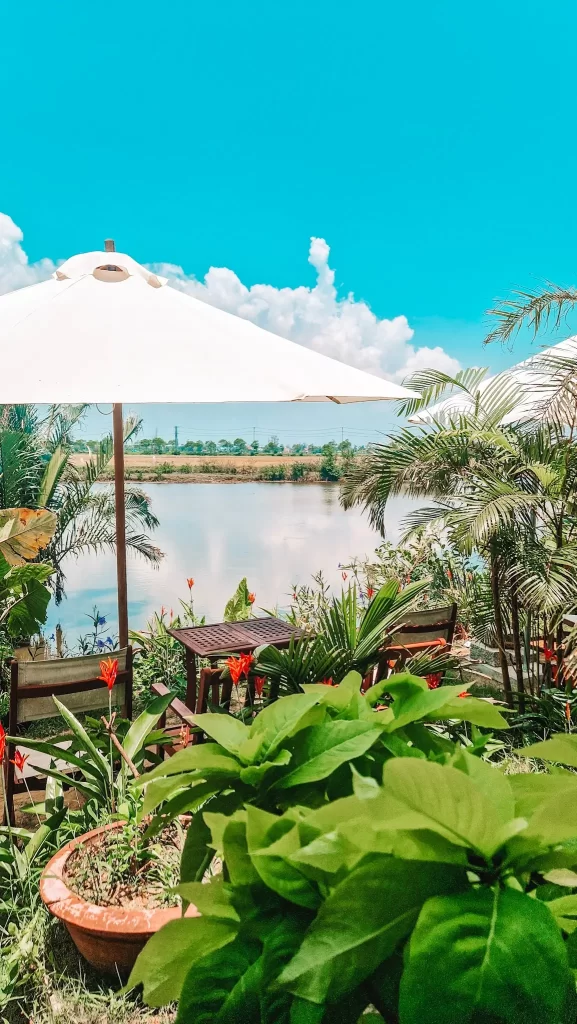
Vietnam is stunning, and compared to other countries in Southeast Asia, it’s still easy to find unique and authentic experiences outside of the cities. This guide is crafted especially for the curious and culturally minded. If you’re looking for day trips that blend history, natural beauty, and a touch of adventure—like visiting the ancient ruins of My Son Sanctuary, climbing through the mystical Marble Mountains, or catching the sunset at An Bang Beach—you’re in the right place.
The best day trips from Hoi An or Da Nang
These are some of the best day trips from Da Nang or Hoi An:
- My Son Archaeological Site – Best for lovers of ancient and modern history
- Lady Buddha – Best for people wanting a short, peaceful day trip
- Hue – Best for history-lovers short on time
- An Bang Beach – Best for beach lovers
- Hai Van Pass – Best for exploring Vietnam’s scenic countryside
- Bana Hills – Best for lovers of the spectacular
- Ride through Hoi An’s rice fields – Best for active people or those looking for peace
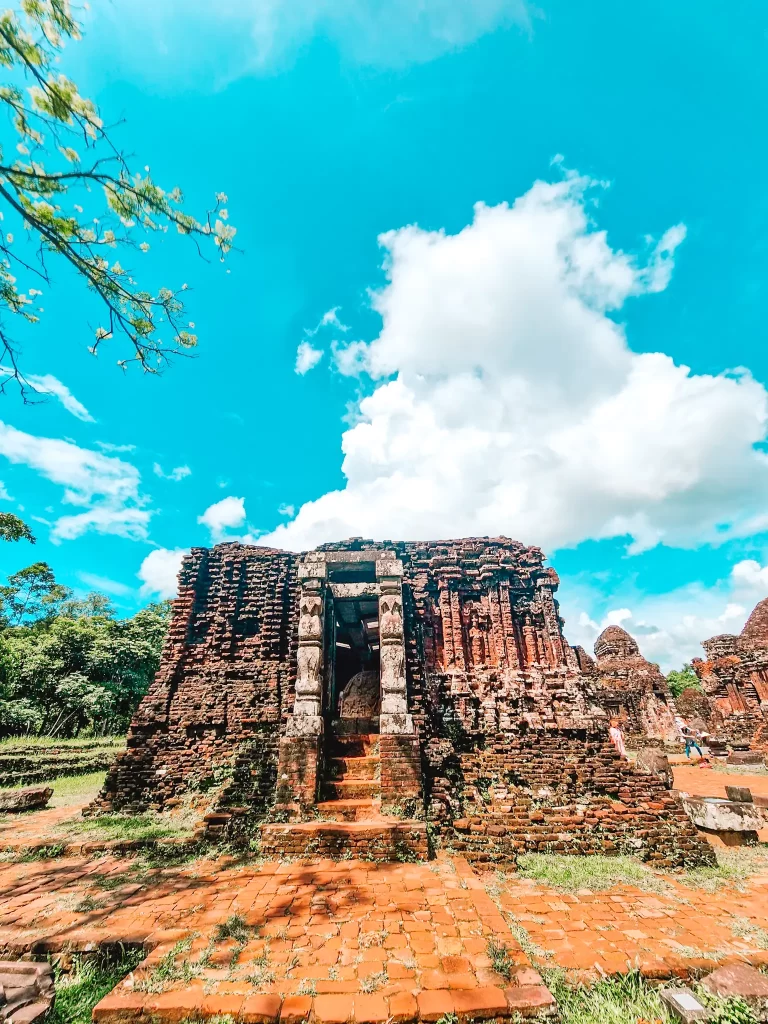
Marvel at the Marble Mountains
Cost:
- 40K VND entrance fee + 15K VND to get the lift (recommended)
- 50K VND to hire a guide for your group (if not on a guided tour)
As you drive into Da Nang, you can’t help but notice the Marble Mountains. These limestone karsts jut from the ground dramatically, looming above the otherwise flat landscape in this part of Vietnam.
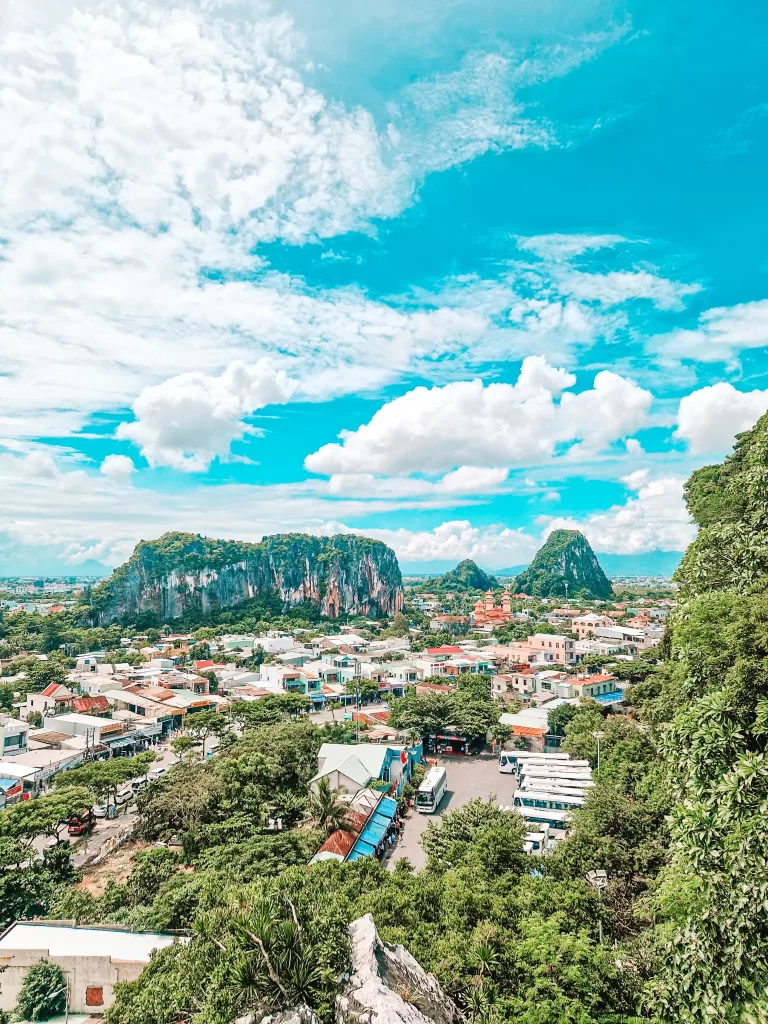
The temples in the mountains date back to the 17th Century, and were named after the five key elements in Buddhist Tradition: Water, Metal, Wood, Earth and Fire. While four have been destroyed by overmining, it’s still possible to visit the Water Mountain, which has both beautiful temples and dramatic caves.
As you enter on your day trip from Hoi An, you’ll first descend into Hell (literally), climbing down into dank caves full of moisture and dripping water. They’re also full of carvings and statues, depicting scenes from Buddhist Hell, with demons torturing sinners. This is absolutely not what I was expecting when I visited, but it was very interesting (and definitely worth the fact that the dampness in the caves makes the heat and humidity even worse than outside).
After exploring the Hell Cave, you’ll ascend toward the Heaven area. I recommend taking the lift (elevator), as there are a lot of steps – over 150 to get to the Heaven area. If you’re worried about missing out on exercise, don’t worry – there are plenty more steps to reach the absolute top of the mountain even after you’ve taken the lift.

The Heaven area of the Water Mountain is truly beautiful, offering different temples and photo spots. You’ll find the Tam Thai Pagoda, a beautiful temple originally built in the 17th Century, and the stunning Huyen Khong Cave, where light streams in from above.
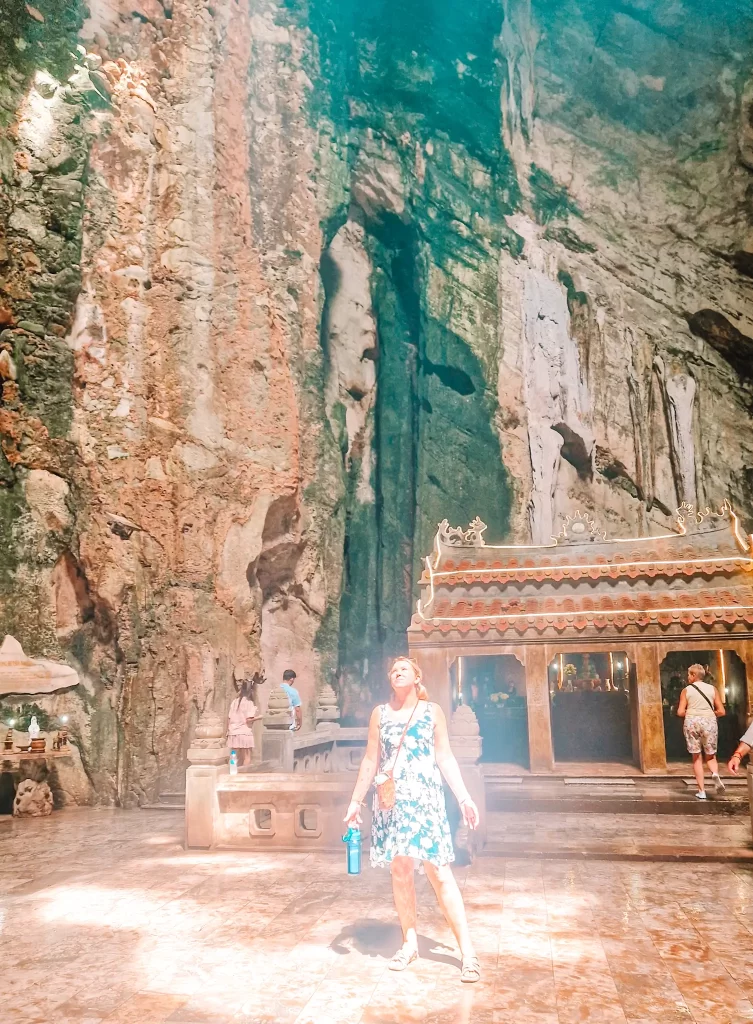
At the very top, you’ll climb again to a pagoda at the side of the mountain, offering stunning views of the other mountains and Da Nang in the distance.
Practicalities:
It’s easy to visit the Marble Mountains independently, as they are between Da Nang and Hoi An. However, if you do, you’ll miss out on a lot of the nuance of their history and religious significance. I recommend hiring a guide when you get there.

If you choose to take a guided tour, this is likely to be combined with the Lady Buddha, and a couple of tourist stops: a visit to a marble workshop (fascinating, but well out of my price range) and a trip to a family-run rice paper shop. I Ioved the rice paper experience. We got to meet the older lady who ran the business, and learn about her family history, dating back to the turn of the century.
You might also be able to visit the Marble Mountains as part of a tour of the Hai Van Pass.
Understand Vietnam’s ancient past at the My Son archaeological site
Cost: 150K VND entry fee
Before Vietnam became a fully unified country, the central region was part of the Champa Kingdom, a powerful kingdom that ruled central and southern Vietnam from the 2nd to 17th century. The Champa Kingdom was eventually conquered by the Viet Kingdom, which absorbed their provinces one by one.
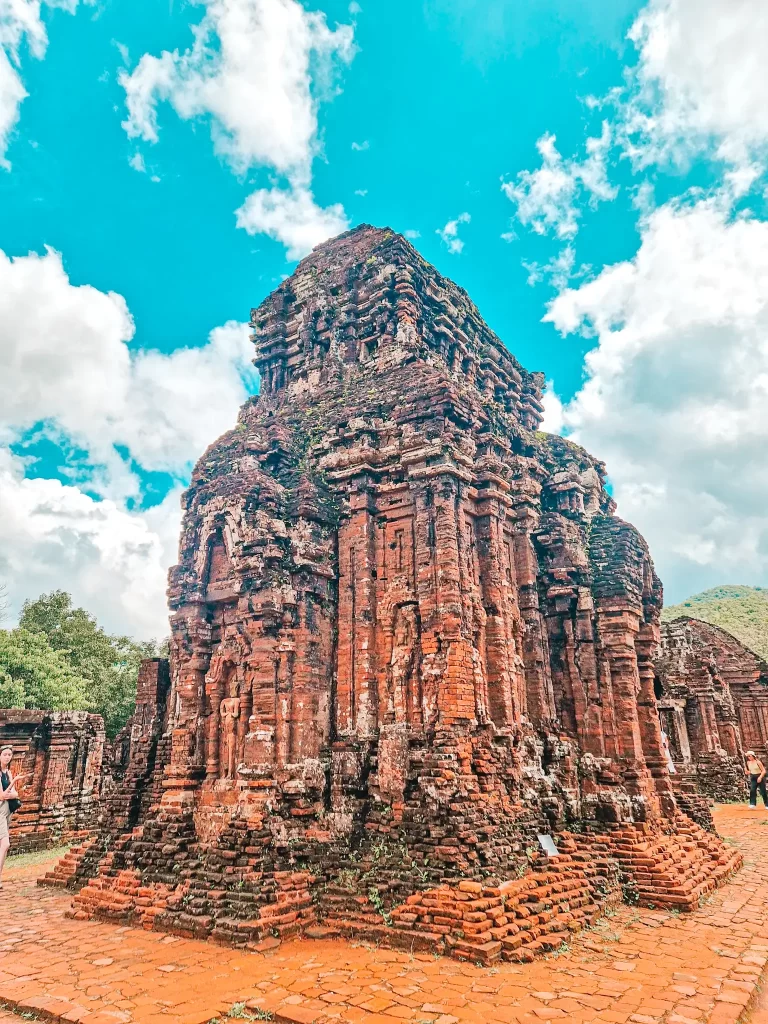
This popular day trip from Hoi An is only about an hour south of the city. My Son is one of the most significant Champa sites in Vietnam, and also has a strong link to Vietnam’s more recent history. There are a number of stunning Hindu temples, with brickwork that is so intricate that modern archaeologists and builders have been unable to recreate the construction method. You’ll also get a chance to see a traditional Champa dance show during your visit.
Like Hoi An, My Son is a UNESCO Heritage site, and one of the things I most enjoyed at the site was understanding the different conservation methods being used – for example, there were different areas of the site being overseen by archaeologists from different countries.

My Son is also an important site to understand Vietnam’s significantly more recent history. It was badly damaged during the Vietnam War, and this is still visible in many of the buildings. More alarmingly, there are still huge bomb craters around the site, preserved to show the impact of war on archeology.
Practicalities:
While you can visit My Son independently, as with any historic site I strongly recommend a guided tour. Without a competent guide, you’re unlikely to get much out of the visit, as you’ll miss the history and nuance.
This is usually a half day trip, lasting 3-4 hours. I visited My Son as a morning trip, but sunrise options are also very popular. As the site is in a valley, it’s significantly more humid than other areas of central Vietnam (our guide even brought a spare shirt and changed at lunchtime) – so a sunrise tour could help avoid this heat as well as the crowds there when I visited.
Be awed by the serene beauty of the Lady Buddha
Cost: free to enter
The beautiful Lady Buddha statue towers over Da Nang, visible from My Khe beach on a clear day. Built between 2004-2010, she is 67 metres tall and the largest Lady Buddha in Southeast Asia. When I visited, our guide told us that locals in Da Nang credit her presence with saving them from serious damage during Vietnam’s annual typhoon season – locals say there hasn’t been serious storm damage since she was built.

You can visit her at the Monkey Mountain, about 15 minutes from the main tourist area of central Da Nang. The site also includes a temple in her base, as well as other temples on site and stunning panoramic views over Da Nang.
Be aware that Monkey Mountain has that name for a reason – the first time I visited, I didn’t see any monkeys, but more recently there were a huge group up at the statue. While they don’t have the same reputation for aggression as those in Ubud and the Batu Caves in Malaysia, they will steal things that are left unattended – I saw one steal a drink from someone’s motorbike!

Practicalities:
The Lady Buddha is easy to visit and doesn’t require a guide. As this is a religious site, made sure your shoulders and knees are covered, and remove your shoes before entering temples.
Try to avoid having plastic bags as monkeys associate these with food, and don’t leave your things unattended if the monkeys are around!
This is only a short day trip from Hoi An or Da Nang, and it makes for a peaceful, low intensity activity to get you away from the cities.
Understand Vietnam’s Imperial Past in Hue
Cost: depends on the sites chosen, but a combo ticket for the Imperial City, Tu Duc Tomb and Khai Dinh Tomb is 420K VND
Around two hours’ drive from Da Nang, Hue is a popular central Vietnam day trip from either Hoi An or the Dragon City. This trip is more intense than others in this list, and will require a full day.
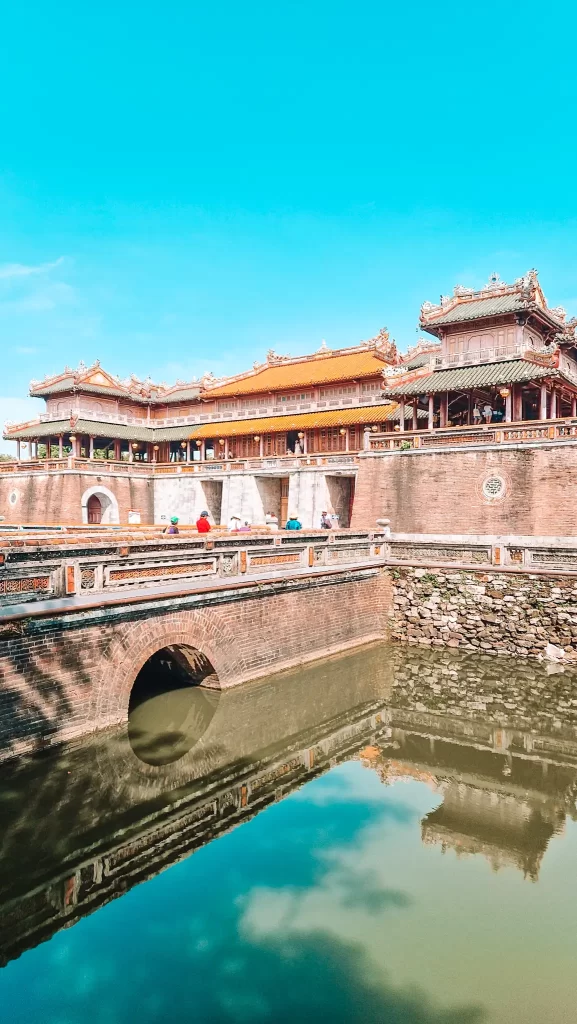
Once the capital of the Vietnamese Kingdom, Hue is another UNESCO site which still has enormous Imperial Palaces, an imposing Imperial Citadel, and the ornate tombs of many of the later Emperors. A visit to Hue will help you to understand the Viet Kingdom both before and after French colonisation, as well as giving an insight into why the Kingdom came to an end after the Second World War.

There is so much to see and do in Hue – I have a full post on the different imperial sites including the Imperial City, the more austere Tomb of Tu Duc, and the incredibly ornate Tomb of Khai Dinh, the penultimate Emperor.
Practicalities:
There are a number of different ways to get to Hue from Da Nang or Hoi An including bus, train and motorbike. However, if you are doing this as a day trip, I recommend taking a guided tour that will pick you up in your chosen city. A guided tour will:
- Help you to understand the complex historic context of multiple sites in Hue
- Ensure you use your time efficiently, moving you between sites to allow you to see as much as possible in one day
- Take care of ticketing, so you avoid wasting time in queues
Even if you choose to travel to Hue independently, I strongly recommend a guided tour of the historic monuments. I visited without a guide when I came to Vietnam in 2010, and can still vividly remember how frustrating it was not to understand anything across these beautiful historic sites.
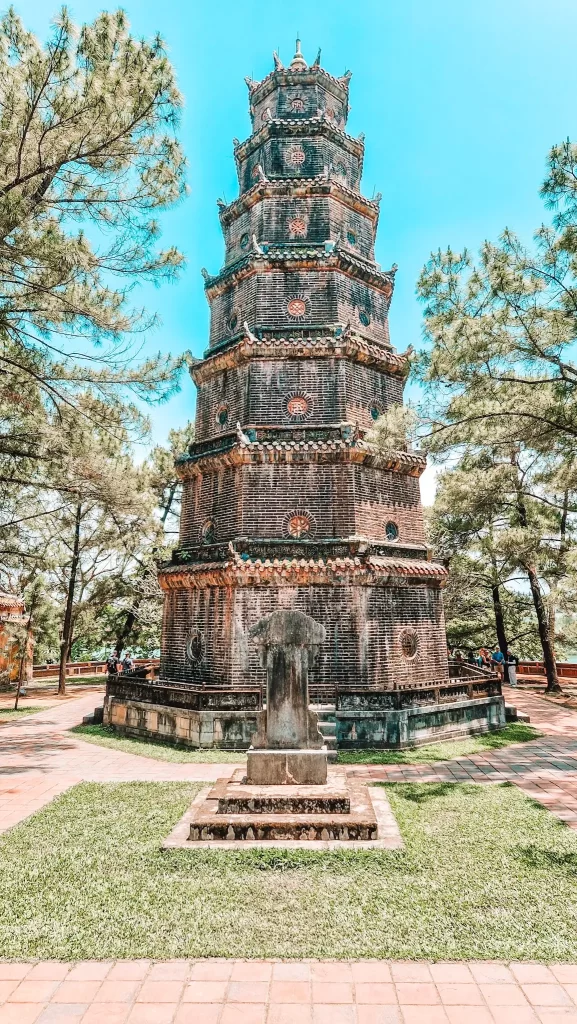
Visiting Hue on a day trip from Da Nang or Hoi An is very possible, but a long day. If your itinerary allows, consider staying a night or two in Hue (as I did) and combining it with the Hai Van Pass. You can then proceed on to Ninh Binh or Hanoi as part of your north Vietnam itinerary.
Laze on the gorgeous An Bang Beach
Cost: 50K VND for a sunbed
While Da Nang’s My Khe beach is gorgeous, and one of the longest in Asia, I often found it too busy and loud for true beach lazing. The noise from beach bars and the sheer number of people passing by made it a bit too intense for me during my time living in Da Nang.

An Bang Beach, however, just outside Hoi An, is much more relaxed. Much smaller and quieter, this gorgeous golden shoreline still offers great amenities – there are more beachfront restaurants, for example, as well as plenty of sunbeds. While it does still get busy, the vibe is much more relaxed, with no blaring music.
Treat yourself to a day trip from Hoi An or away from the hustle of Da Nang, and simply relax. Get a massage in An Bang at Jasmine’s during the day, or try dinner at Ken’s Vegetarian, who will whip you up a veggie version of Cao Lao, the local Hoi An noodle dish.
Practicalities:
An Bang beach is about 10 minutes drive from central Hoi An. You can take a taxi, a Grab Bike (around 30K VND), or cycle through the rice fields. Many of the bigger hotels may also offer shuttles.

It’s about 40 minutes from Da Nang. You can take a shared shuttle during the day. A Grab Bike should cost about 120K VND and a Grab Taxi around 300K VND.
Sun beds should cost about 50K VND per person (April 2025). The restaurants on the beach offer toilet facilities.
Hai Van Pass
Cost: $42 USD for a one way Easyrider tour with Motorvina
Once you’ve had your day of rest on An Bang beach, it’s time for something much more intense! Head out onto one of Vietnam’s most scenic roads for a ride along the ocean and up into the mountains to Hue.
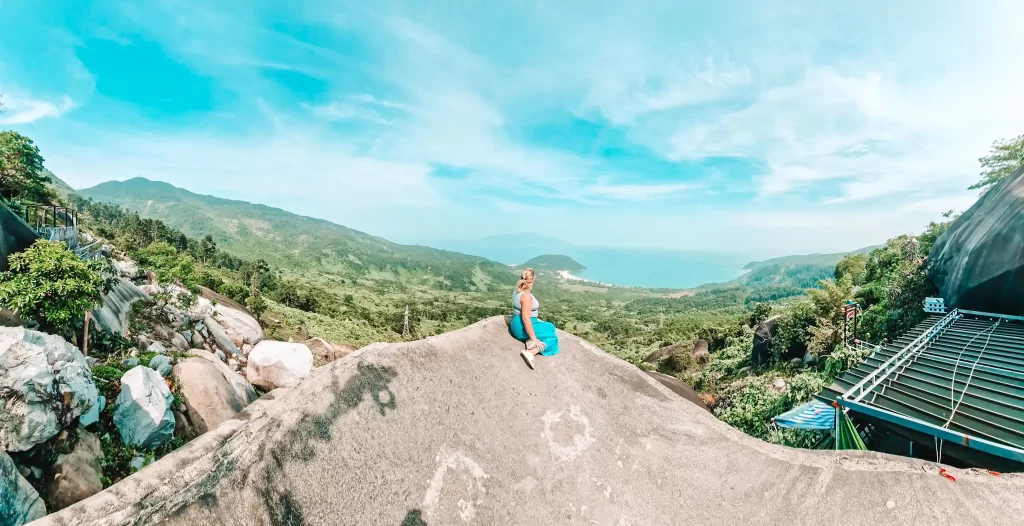
The Hai Van Pass runs between Da Nang and Hue, and represents a strategic point in Vietnam’s geography, separating north and south. It’s now a dream of a road to ride a motorbike, because a new tunnel means that the scenic road is now mostly free of traffic, with only bikes and the occasional tour bus using it.
Practicalities:
I wrote a full guide on my Easyrider tour of the Hai Van Pass in April 2025, and loved every moment of being an Easyrider passenger on this full day ride from Hue to Da Nang. However, if you want to do it as a day trip, a round trip option is available, either as an Easyrider or to ride independently. You could go as far as Lang Co Beach, where I had lunch, before turning back, for example.

You can also visit the Hai Van Pass as part of a day trip to Hue, with many tour buses taking you through the pass. Note, however, that these won’t make stops. If you want to truly visit the pass with stops via bus, you can also look for this as a separate option.
If you are riding independently, note that you must wear a helmet. Be aware that while the road is in good condition, it might be challenging if you’re not a confident rider because of the steep sections.
Bana Hills
Cost: 900K VND entrance cost
It’s hard to look up Da Nang without coming across Bana Hills, the enormous amusement/attraction park in the hills near the city. Famous among Westerners for the many Instagram shots of the bridge that’s held with giant hands, it’s much more than that!
An enormously popular day trip from Da Nang, it’s run by the Vietnamese tourism company SunWorld, who also run the access to Fansipan Mountain via the cable car near Sapa. Bana Hills is a theme park meets Instagram dreamscape, with a number of rides and a French village, as well as cultural performances and exhibitions.
While I never made it to Bana Hills, it’s an extremely popular destination, and definitely worth considering as part of your central Vietnam itinerary.
Practicalities:
Bana Hills is about 1.5 hours from Da Nang and up to 2 hours from Hoi An. You can organise tickets that also include transport for a seamless day, for example through Get Your Guide. You can also take a private car, although I would suggest also organising pick up rather than relying on Grab to get you home.
Ride through Hoi An’s rice fields
Cost: small fee to rent a bike, depending on the provider
Hoi An’s rice fields are stunningly beautiful. They stretch out between central Hoi An and An Bang, with paths arching off the road guarded by buffalo (and their owners, looking to sell you a ride). This is more of a morning trip than a day trip, particularly if you are visting while it’s hot, but don’t miss the chance to explore Hoi An’s gorgeous rural landscape.
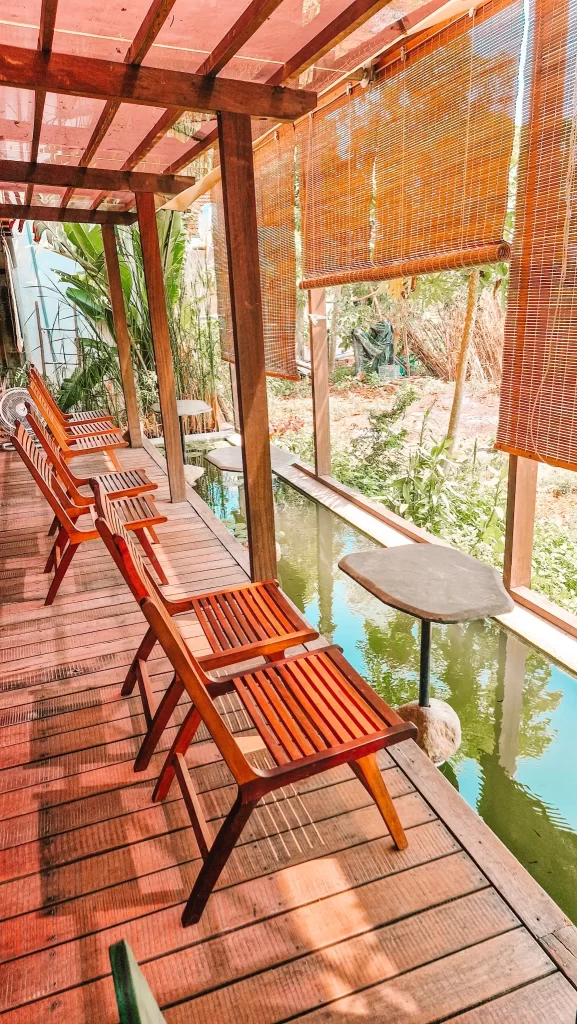
I most explored this area by Grab bike, hopping between gorgeous cafes as I worked on Em’s Globetrotting Gems.
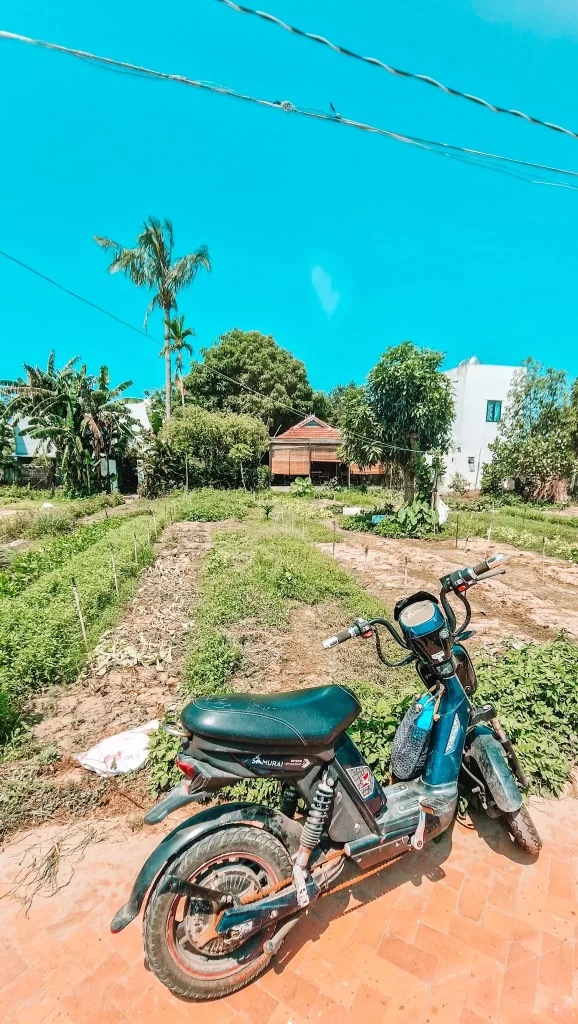
Practicalities:
Most people do this by bicycle, either independently or as part of a tour. If you choose a tour, you can often combine it with a buffalo ride, your coconut boat ride and a cooking class at a restaurant hidden away in the rice fields. If you’re going independently, look up some of the beautiful cafes in the area first, and plot a course between them.
You can source a tour via a provider like Get Your Guide, or via your hotel in Vietnam. Most hotels also offer bicycle rental, or there are many places in Hoi An that also offer bike rental.
Frequently Asked Questions
Where are Hoi An and Da Nang?
Hoi An and Da Nang are two cities in central Vietnam. They’re about 45 minutes – 1 hour apart, with transport easily available between the two. Da Nang has a major international airport, meaning that many people will arrive into central Vietnam via Da Nang, especially on internal flights from Ho Chi Minh City or Hanoi.
If you’re keen to know more about Vietnam and its recent history, check out the books written by Vietnamese authors in my guide to powerful books about Southeast Asia.
Is Vietnam a good destination for solo female travelers?
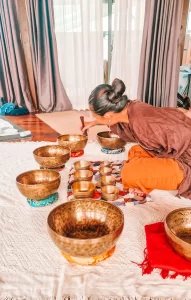
Absolutely. Both Da Nang and Hoi An are considered safe and welcoming for solo travelers, including women. Use the same precautions you would at home—avoid poorly lit areas late at night and use Grab instead of unlicensed taxis.
Both Da Nang and Hoi An offer numerous Facebook groups for travellers who are staying a bit longer – including ones specifically for women. These are a great source of ad-hoc events in the area, such as the sound bath I enjoyed in Da Nang.
Are Hoi An and Da Nang Safe?
Many travelers wonder about safety in Vietnam. The good news is that Da Nang and Hoi An are considered two of the safest cities in Vietnam for travelers. The An Thuong area of Da Nang in particular is very friendly and welcoming. Hoi An is a very touristy town, and busy into the evening, so there are almost always people around. However, take the usual precautions, particularly if you are out late at night. For example, make sure to use Grab (the Asian version of Uber) rather than unlicensed taxis or motorbikes.
The British Foreign, Commonwealth and Development Office (FCDO) states that the most frequent types of crime in Vietnam are bag snatching and theft. However, rates of crime in Da Nang are very low and Hoi An is considered one of the safest cities in the world for solo travellers. People often leave bags – and even laptops – at tables in cafes. That said, it’s still wise to take standard precautions, especially late at night.
When is the best time to visit central Vietnam?
The best time to visit central Vietnam, including Da Nang and Hoi An, is the peak tourist season, from April to August. This offers drier weather and sunnier days, although temperatures do get very high later in this season, reaching 40c in July and August.
September to March is considered the wet season, and is less popular with tourists.
I was in Da Nang in late February and March in 2025, and the weather was very variable. Some days had beautiful sunshine, while others had drizzling rain. By April, summer had arrived and it was very hot.
How to get to Da Nang and Hoi An: Air
Da Nang International Airport is about 15 minutes’ from Da Nang and less than an hour from Hoi An. It’s a modern airport with excellent facilities. Regular flights arrive from domestic destinations including Hanoi and Ho Chi Minh City, as well as international destinations like Bangkok, Kuala Lumpur, Singapore and Siem Reap.
The best way to get from the airport to Da Nang is via Grab. This is quick and cheap, and should cost about 100K VND-130K VND depending on the time of day and demand. To get to Hoi An, you can also take Grab for about 300K VND. You can also ask your hotel to organise a private transfer, or I was able to get a free transfer to my Da Nang hotel via a Booking.com special offer with my hotel booking.
While there are public buses, these tend to focus on main part of the city, and don’t usually reach the An Thuong area where most hotels are located. There are also shared shuttle buses, which you can book via 12goAsia – I used these to get from Da Nang to An Bang and it was quick and easy.
How to get to Da Nang and Hoi An: Train
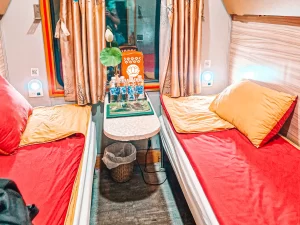
Da Nang is one of the main stations on Vietnam’s extensive railway network, which stretches from Ho Chi Minh City in the south to Hanoi and even Sapa in the north. Trains arrive and depart from Da Nang Train station, with departures to key destinations several times a day. The train station is about 15 minutes drive from central Da Nang, and about 1 hour from Hoi An.
Train journeys from Da Nang, aside from Hue, tend to be long:
Hanoi – 17 hours
Ho Chi Minh – 19 hours
Hue – 2.5 hours
I wrote a full guide on the Vietnamese trains I took from Hoi An (via the train station in Da Nang) to Ninh Binh, and then from Hanoi to Sapa, because I loved the experience!
How to get to Da Nang and Hoi An: Bus
Vietnam’s buses have gained internet fame in recent years, with the VIP Sleeper buses offering some of the best luxury bus travel in the world. Taking a bus from Da Nang or Hoi An to other destinations across Vietnam is a popular option, with destinations including Ninh Binh, Hanoi, Ho Chi Minh City, Hue, Nha Trang and others.
Buses arriving and departing Da Nang will usually operate from bus company offices across the city, rather than a central bus station. The best way to get from these to your destination is usually Grab. Buses in Hoi An have a range of departure points across the city, as big buses can’t enter the Old Town area. You’ll need to work out the best departure point for you, or some will offer a free pickup service via minivan.
Buses in Vietnam vary in terms of comfort and price, for example VIP sleeper Buses offer wide beds with a seat on either side of the aisle, while cheaper sleeper buses have much less space as they have three beds per row. Do your research in advance to find out the best options for you – I read reviews on 12goasia and on Google before selecting a company.
Is it easy to get around Da Nang and Hoi An without speaking Vietnamese?
Yes, in most tourist areas, basic English is widely spoken, especially by hotel staff, tour guides, and Grab drivers. That said, learning a few phrases like “Xin chào” (hello) or “Cảm ơn” (thank you) is appreciated and can enhance your experience.
Make sure you have Google Translate downloded onto your phone for any more compex situations.
Where Should I Stay in Da Nang
Da Nang has a specific area dedicated to tourists – the An Thuong Tourist Streets. Right on My Khe Beach, this area has the most restaurants, bars and coffee shops in Da Nang. There’s an abundance of hotels to suit every budget. However, if you choose a hotel further down My Khe beach in Son Tra, you can find some really good deals.
Most of the activities in this guide are within walking distance of this area. There are a few exceptions, including Han Market and Son Tra Market, and Son Tra Marina. If you haven’t rented your own bike, the best option to get to these is Grab Bike.
Options include:
Golden Lotus Da Nang – this popular hotel is just off An Thuong and often sold out. It has a rooftop bar and a small shop in the reception, and is right next to my favourite cafe in Da Nang for salt coffee. It has a 9.4 rating on Booking.com from over 1.7k reviews.
Ha Trieu Hotel – I stayed at this hotel when I first arrived in Da Nang, and it was also recommended to me by a friend. It’s not in the main tourist area, but further down the beach, near a quieter beach area. It’s also near the gorgeous Wind Cafe and one of the best vegan restaurants in Da Nang.
Where Should You Stay in Hoi An?

There’s an abundance of choice for hotels in Hoi An, from charming local stays to riverside resorts. While there are hotels in the Ancient Town itself, I’d personally be cautious about choosing these, as Hoi An is a town that really comes alive at night and you’re likely to experience street noise.
You can also choose to stay on one of the two islands opposite the main town. An Hoi is where the main night market happens, and the front street is lined with bars – I would avoid these areas. Beyond this, the back streets of the island are quieter.
I stayed on Cam Nam, where there are far fewer tourists. This quiet island is about 10 minutes walk from the Ancient Town, but feels a million peaceful miles away. While there are a number of hotels, there are still lots of private houses, and it feels much less touristy.
If you can afford it, there are also a lot of beautiful upmarket hotels lining the river. These have stunning views and are usually away from the noise of the main town.
Options include:
Yen Villas (pictured) – this is where I stayed, and I can’t recommend it highly enough. Rooms are spacious and clean. The aircon works, and there is a beautiful small pool. The family running the small hotel are among the most helpful and kind people I’ve come across while travelling. It’s around $15 per night.
Hoi An Town Centre Hotel – on An Hoi, this highly rated hotel is budget/mid-range for Vietnam (around $20 a night). It has excellent reviews, and is away from the noise of the night market.
River Town Hoi An Resort and Spa – also on An Hoi, but on the riverfront, this 5* resort has over 2000 reviews, a 4.7 rating on google and costs around $75 per night.
Mulberry Collection Silk Eco – if you’re keen to stay on the mainland, this 4* hotel has over 700 reviews on google and a 4.5 rating.
Are there vegetarian or vegan options in Central Vietnam?

Yes! Vietnamese cuisine has excellent plant-based dishes, and you can find dedicated vegetarian and vegan restaurants in both Hoi An and Da Nang. Popular dishes include bánh xèo (local pancakes) with mushrooms, veggie pho, vegetable spring rolls and vegan versions of cao lầu.
Whether you’re chasing history, coastal views, or simply a fresh perspective, these day trips from Hoi An and Da Nang offer the perfect balance of culture, nature, and adventure. After exploring them myself—sometimes on the back of a motorbike, other times with a book in hand at a quiet countryside café—I can confidently say they’re worth the detour. I hope this guide helps you make the most of your time in Central Vietnam, and reminds you that the magic often begins just outside the city.


